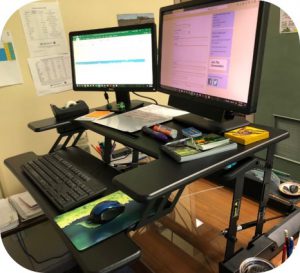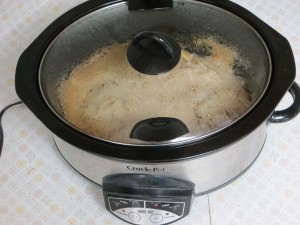
Take Care of Your Bones
 Take care of your bones today for better quality of life tomorrow!
Take care of your bones today for better quality of life tomorrow!
According to the National Institutes of Health, about one in every two Americans over the age of 50 may already have or be at risk of developing osteoporosis. (1) Osteoporosis is a disease where, over time, bone quality and strength decline, making bones more likely to fracture and break. Fractures can develop not only as a result of a slip or fall but also from everyday sneezing or coughing. If your doctor diagnoses you with osteoporosis, the best course of action for slowing its progression may be prescription medication. However, nutrition and exercise can help provide a good foundation to prevent or delay disease development. (1)
Know Your Risks
While all risks are not completely understood, there is a genetic factor linked to osteoporosis – mainly, if poor bone mineral density runs in the family. In addition to genetic factors, poor nutrition, smoking, excessive alcohol, and a lack of exercise can all increase your risk of developing osteoporosis. It is important to talk to your doctor to discuss your level of risk and prevention measures. (1)
Build More Bone
Although they may not seem like it, bones are a living tissue and go through times of building and breakdown during the life cycle. Bones grow the most during childhood, but they also change and become stronger as an adult by doing exercises like weightlifting or running. (1) Similar to a savings account or retirement fund, the more you build when you are young, the more you can afford to spend as you age. Current recommendations to support strong bones include muscle strengthening exercises at least two times per week. These exercises require your muscles to do more work than doing just day-to-day activities. Additionally, strength training exercises should be done to the point where it would be difficult to perform one or two more repetitions. Examples include lifting weights, working with resistance bands, and doing body weight exercises such as push-ups, pull-ups, and planks. Additionally, climbing stairs, and carrying heavy loads (such as groceries and heavy gardening) also count when done frequently.(2)
Support Your Bones
In addition to exercise, nutrition plays a large role in promoting healthy bones. The two most important nutrients for bone health are calcium and vitamin D. Calcium is what gives bones their strength but is also involved in many other processes in the body. If you do not regularly consume enough calcium, your body takes it from your bones. (3) If this happens for long enough, your bones will become weakened and begin to develop osteoporosis. Vitamin D is important for the absorption of calcium. Not having enough vitamin D can impact your bones, even if you get enough calcium from your diet. (4)
| Life-stage group | Calcium (mg/day) | Vitamin D (IU/day) |
| Infants 0-6 months | 200 | 400 |
| Infants 6-12 months | 260 | 400 |
| 1-3 years old | 700 | 600 |
| 4-8 years old | 1,000 | 600 |
| 9-13 years old | 1,300 | 600 |
| 14-18 years old | 1,300 | 600 |
| 19-30 years old | 1,000 | 600 |
| 31-50 years old | 1,000 | 600 |
| 51–70-year-old males | 1,000 | 600 |
| 51–70-year-old females | 1,200 | 600 |
| > 70 years old | 1,200 | 600 |
| 14-18 years old, pregnant/lactating | 1,300 | 600 |
| 19-50 years old, pregnant/lactating | 1,000 | 600 |
Recommended Calcium and Vitamin D Intakes (5) Definitions: mg = milligrams; IU = International Units
Bone Strengthening Foods
There are a variety of food sources that provide calcium and vitamin D. Calcium can be found in dairy products, green vegetables, and calcium-fortified foods. Examples of calcium-containing dairy products include cheese, yogurt, and reduced-fat milk. Other calcium-fortified foods include breads, orange juice, cereals, and tofu. When it comes to vitamin D in your diet, be sure to include fatty fish such as tuna and salmon. There are smaller amounts of vitamin D found in cheese, mushrooms, and beef liver. Similar to calcium, there are many vitamin D-fortified foods available. Some examples are cereals, orange juice, milk, and milk products. Check out the two tables below for calcium and vitamin D food sources. (5)
Calcium Content of Selected Foods
| Food | Serving size | Milligram (mg) per serving | % DV |
| Sardines, canned in oil | 3 oz | 324 | 32% |
| Cheddar cheese, shredded | 1 ½ oz | 306 | 31% |
| Nonfat milk | 8 oz | 302 | 30% |
| Yogurt, reduced fat, no solids | 8 oz | 300 | 30% |
| 2% milk (reduced fat) | 8 fl oz | 297 | 30% |
| Whole milk | 8 fl oz | 291 | 29% |
| Cottage cheese, 1% milk fat | 2 cups, unpacked | 276 | 28% |
| Mozzarella, part skim | 1 ½ oz | 275 | 28% |
| Tofu firm, with calcium | ½ cup | 204 | 20% |
| Orange juice, calcium fortified | 6 fl oz | 200-260 | 20-26% |
| Tofu soft, with calcium | ½ cup | 138 | 14% |
| Frozen yogurt, vanilla, soft serve | ½ cup | 103 | 10% |
| Ready-to-eat cereal, calcium fortified | 1 cup | 100-1000 | 10-100% |
| Turnip greens, boiled | ½ cup | 99 | 10% |
| Kale, raw | 1 cup | 90 | 9% |
| Vanilla ice cream | ½ cup | 85 | 8.5% |
| Soy beverage, calcium fortified | 8 fl oz | 80-500 | 8-50% |
| Flour tortilla | 1, 6” diameter | 37 | 4% |
| Sour cream, reduced fat, cultured | 2 Tbsp | 32 | 3% |
Adapted from Office of the Surgeon General (US). Bone Health and Osteoporosis: A Report of the Surgeon General. (7)
Vitamin D Content of Selected Foods
| Food | Serving size | Micrograms (mcg) per serving | International Units (IU) per serving | Percent DV |
| Cod liver oil | 1 Tbsp | 34 | 1,360 | 170 |
| Rainbow trout, cooked | 3 oz | 16.2 | 645 | 81 |
| Salmon (sockeye), cooked | 3 oz | 14.2 | 570 | 71 |
| White mushrooms, raw, exposed to UV light | ½ cup | 9.2 | 366 | 46 |
| 2% milk, vitamin D fortified | 1 cup | 2.9 | 120 | 15 |
| Soy, almond, & oat milk, vitamin D fortified | 1 cup | 2.5-3.6 | 100-144 | 13-18 |
| Ready-to-eat cereal, fortified with 10% DV vitamin D | 1 serving | 2.0 | 80 | 10 |
| Sardines (Atlantic), canned in oil, drained | 2 | 1.2 | 46 | 6 |
| Egg, scrambled | 1 large | 1.1 | 44 | 6 |
| Beef liver, braised | 3 oz | 1.0 | 42 | 5 |
| Tuna fish (light), canned in water, drained | 3 oz | 1.0 | 40 | 5 |
| Cheddar cheese | 1.5 oz | 0.4 | 17 | 2 |
| Portabella mushrooms, raw, diced | ½ cup | 0.1 | 4 | 1 |
| Chicken breast, roasted | 3 oz | 0.1 | 4 | 1 |
| Ground beef, 90% lean, broiled | 3 oz | 0 | 1.7 | 0 |
| Broccoli, raw, chopped | ½ cup | 0 | 0 | 0 |
Adapted from Vitamin D – Fact sheet for health professionals (8)
Stay Safe and Healthy as You Age
Osteoporosis can be a serious and life changing diagnosis. However, adopting healthy habits like limiting smoking and excessive alcohol consumption can decrease your risk. Consuming enough calcium and vitamin D each day and getting regular muscle building exercise at least twice a week can also help protect your bones. Women over the age of 65, or anyone diagnosed as “at risk,” should be regularly screened for osteoporosis by a doctor during their yearly physical health exam. (6,7,8)
Making healthy lifestyle choices from a young age can help prevent or delay osteoporosis, but once you’re diagnosed, the best course of action for slowing its progression may be prescription medication. Consult your doctor before beginning a new exercise program or for interactions with medications.
References
- “Osteoporosis Overview.” National Institutes of Health, U.S. Department of Health and Human Services, https://www.bones.nih.gov/health-info/bone/osteoporosis/overview.
- S. Department of Health and Human Services. Physical Activity Guidelines for Americans, 2nd edition. Washington, DC: U.S. Department of Health and Human Services; 2018.
- “Osteoporosis.” Edited by Susan Randall, Osteoporosis | Office on Women’s Health, National Institute of Arthritis and Musculoskeletal and Skin Diseases, 20 May 2019, https://www.womenshealth.gov/a-z-topics/osteoporosis.
- “Office of Dietary Supplements – Vitamin D.” NIH Office of Dietary Supplements, U.S. Department of Health and Human Services, 22 Mar. 2021, https://ods.od.nih.gov/factsheets/vitaminD-HealthProfessional/
- S. Department of Agriculture and U.S. Department of Health and Human Services. Dietary Guidelines for Americans, 2020-2025. 9th Edition. December 2020. Available at DietaryGuidelines.gov
- Palmer S. Bone Health and Diet. Today’s Dietitian. 2013;15(2):44.
- Office of the Surgeon General (US). Bone health and osteoporosis: A report of the surgeon general. Rockville (MD): Office of the Surgeon General (US); 2004. Table 7-2, Selected Food Sources of Calcium. Available from: https://www.ncbi.nlm.nih.gov/books/NBK45523/table/ch7.t2/
- Vitamin D – Fact sheet for health professionals. NIH Office of Dietary Supplements. https://ods.od.nih.gov/factsheets/VitaminD-HealthProfessional/#h3. Published August 17, 2021. Accessed November 11, 2021.
Guest contributors: Andrew Treble and Lexi Fraino are master’s students and Dietetic Interns from Florida State University’s Department of Nutrition & Integrative Physiology.






